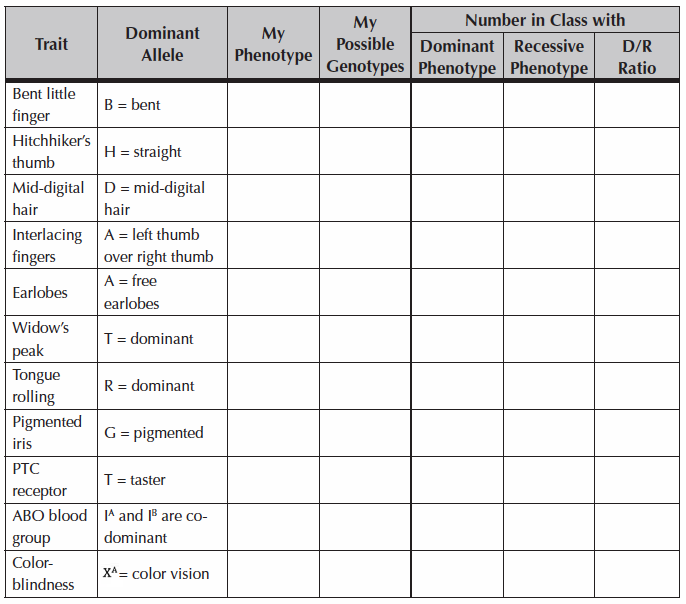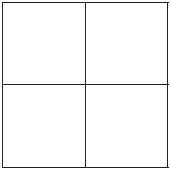Chapter 11. Human Genetics and Mendelian Genetics
Objectives
By the end of the period, students will be able to:
- review the principles of Mendelian genetics using human traits.
- determine the genetic uniqueness of individuals in this room and quantify the number of individuals in the class with dominant and recessive phenotypes for different traits.
- determine the maximum number of traits shared by any two members of the class—start with who looks most alike.
- begin working genetics problems.
This lab will consist of two parts. In the first part, we will perform an exercise in which we will examine the phenotype and possible genotypes of your classmates for a number of different human traits. In the second part, we start solving some genetics problems that will help to reinforce your understanding of the rules of inheritance in humans.
Some Simple Human Traits
Most human traits are controlled by a large number of genes. We are still a long way from understanding how it is a person can have the nose that looks just like their father’s or ears that look like their grandfather’s. However, there are at least 11 traits in humans that are controlled by a single gene pair. In this exercise, we will examine ourselves to determine our phenotypes and possible genotypes for these traits. When you are done recording your own phenotypes, we will calculate the percentage of the entire class that exhibits the dominant or recessive phenotype.
PROCEDURE
For each of the following human traits, determine your phenotype and possible genotypes (Table 11-1).
- Bent little finger (B for bent is dominant over b for straight). Lay your hands flat and relaxed on the table. If the last joint of the little finger bends inward, you have at least one B allele.
- Hitchhiker’s thumb (H for straight is dominant over h for bent). Hold your hand as though you were hitchhiking. If the last joint of the thumb bends way back (more than 60°), you have the recessive trait, hitchhiker’s thumb.
- Mid-digital hair (D for mid-digital hair is dominant over d for no hair). Use a hand lens or dissecting microscope to look for any hair on the middle segment of any finger. If any hair, no matter how fine, is present on any finger, you have at least one D allele.
- Interlacing fingers (A, left thumb over right thumb, is dominant over a, right thumb over left thumb). Fold your hands together with your fingers comfortably interlaced. Check to see which thumb is on top.
- Free or attached earlobes (free earlobes, A, are dominant over attached earlobes, a). If there is any sign of an earlobe hanging down, you have at least one A allele.
- Widow’s peak (a widow’s peak, T, is dominant over a smooth hairline, t). If the hairline dips to a point in the middle of the forehead, a widow’s peak is present. This characteristic cannot be determined if male pattern baldness has changed the hairline.
- Tongue rolling (tongue rolling, R, is dominant over the inability to roll the tongue, r). Stick out your tongue and try to roll it into a tube.
- Pigmented iris (pigmented iris, G, is dominant over non-pigmentation, g). Blue eyes have unpigmented irises and are blue because blue light is more readily reflected from the deeper regions of the iris than are longer wavelengths. Pigmentation results in hazel or brown eyes—any shade other than blue.
- PTC taste receptors (the ability to taste PTC, T, is dominant over the inability to taste it, t). Place a piece of control paper on your tongue. Moisten and chew it. Do you taste it? ________ Repeat the above with PTC paper. Can you taste the PTC?
- ABO blood group (IA and IB are both dominant over iO; IA and IB are codominant). If you know it, record your blood type.
- Red-green color-blindness (color vision, A, is dominant over the inability to distinguish red from green, a, but this gene is sex-linked). Homozygous dominant (XAXA) or heterozygous (XAXa) females have normal color vision. Only homozygous recessive females (XaXa) are colorblind. Since the gene is on the X chromosome, males have only one copy of this gene, obtained from their mother, and the genotype of this copy determines their phenotype.
Table 11-1. Genetic traits of me and my class members.

GENETIC UNIQUENESS
No two individuals produced by sexual reproduction are exactly alike, unless they are identical twins. (Identical twins are produced from the same sperm cell and egg cell—as a result, they share all of their genes.) This portion of the exercise is intended to demonstrate the uniqueness of each individual in the classroom using only the very small number of phenotypic characteristics recorded in Table 11-1.
One person will be selected to stand and read his or her list of characteristics. As he reads the first phenotype on his list, all members of the class who also share that phenotype should stand. When he reads the second characteristic, only those class members who also share this phenotype should remain standing; the others should sit down. Continue this procedure until only the reader is left standing.
How many traits must be compared before all members are seated except the reader?
What does this exercise tell you about genetic uniqueness?
Repeat this exercise by having someone else read their list, starting with different traits each time.
Repeat this exercise by having someone else read their list, starting with different traits each time.
The Why and How of Genetics Problems
Problems exactly as you are doing in lab and lecture are used by genetics counselors to determine the probability of a couple having a child with a certain phenotype and/or genotype. For example, a couple with a history of hemophilia (or many other genetically determined traits) in their family can figure out, even before they become pregnant, what the chances are that their child will inherit the illness. Genetics problems are a helpful method for learning the rules of inheritance.
Before we do some genetics problems, let’s make sure we understand what we are doing. Here are a few very important things to remember:
- Genes for a particular trait always come in pairs (the diploid state), except in gametes. In gametes, there is only one gene for each trait.
- Many (but not all) alleles come in either a dominant or recessive form. In a heterozygote, only the dominant allele is expressed in simple Mendelian genetics. The dominant allele is always represented by a CAPITAL letter, the recessive allele is represented by a lowercase letter.
- Offspring of a mating have a certain probability of having a particular genotype or phenotype. It is this probability that you can determine from a genetics problem.
- The simple rules of inheritance we will be studying were originally discovered and described by Gregor Mendel in the mid-1800s. Although these rules apply to many traits, there are some traits that do not follow the simple rules of Mendelian genetics. For example, for some traits there is incomplete dominance of one allele over another, for some traits there is codominance wherein both phenotypes are expressed (e.g., AB blood types), some traits are linked because the alleles are on the same chromosome, for some traits there are multiple alleles (e.g., human blood groups), and many traits are controlled by more than just one gene pair (e.g., skin color).
Now, we can do a few problems:
Example
In this example we will look at a trait determined by a single gene pair.
The ability to roll your tongue is due to the dominant allele R.
What is the phenotype of a person whose genotype is RR? ______ Rr? ______ rr? ______
Let’s say a male heterozygote for tongue rolling marries a woman who cannot roll her tongue. What is the probability that one of their children will be able to roll his or her tongue?
To answer this question we must determine the alleles for tongue rolling occurring in gametes produced by the two parents during meiosis. Because of segregation (separation) during meiosis, there can be only one gene (one allele) of each gene pair for each trait in each gamete.
What alleles for tongue rolling occur in the gametes of the male?
What alleles for tongue rolling occur in the gametes of the female?
Now, we can use a Punnett square to calculate the probabilities that the offspring will be able to roll their tongue.
This is important: Normally in fertilization only two gametes will come together to produce a single offspring. In other words, in a single fertilization, only one offspring having only one of the possible diploid genotypes will be produced. The question is: What is the probability that, given the genotypes of the parents, an offspring will have a particular genotype and phenotype?
On the top of the Punnett square write the possible alleles that could be found in gametes of one parent for the trait(s) that you are interested in. On the left of the Punnett square, write the possible alleles that could be found in gametes of the other parent for the trait. By matching up the alleles (simulating fertilization) in the square itself, you can determine the probabilities for the genotype and phenotypes of offspring. Fill out the Punnett square:

According to the possible results of fertilization, as shown in the Punnett square, what is the probability that a child of this couple will be a tongue roller?
What is the probability that their child will not be able to roll her tongue?
What is the probability that the child will be a heterozygote for tongue rolling?